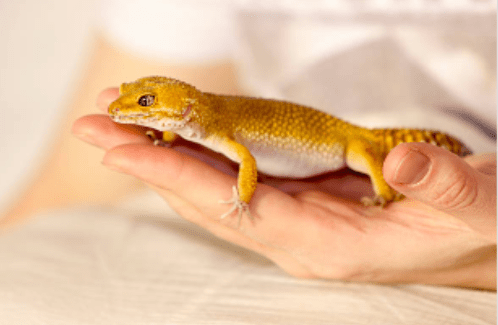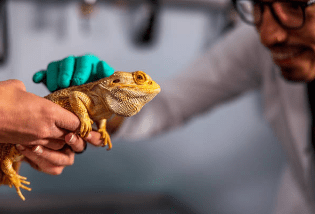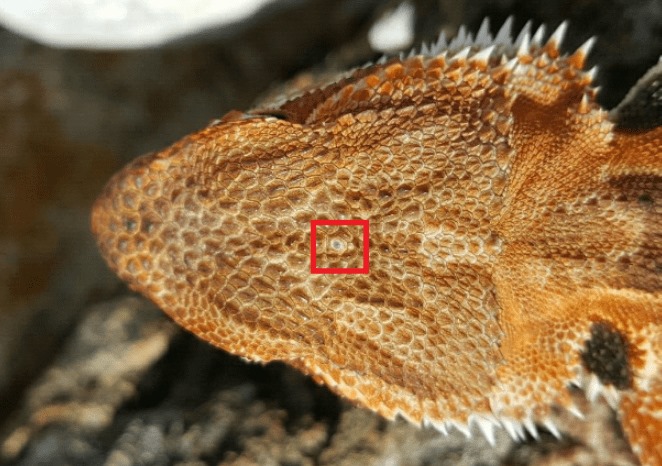Ever stumbled upon a curious spot atop a bearded dragon’s head and thought, “What’s that?”
Welcome aboard the intrigue train.
As a seasoned expert in reptilian anatomy, I’ve delved deep into the fascinating world of bearded dragons.
One topic that always intrigues enthusiasts is the bearded dragon’s third eye.
This guide promises a comprehensive insight into this enigmatic feature. Keep reading, and you might just unravel some mysteries.
Table of Contents
The Mysteries of the Bearded Dragon Third Eye Unveiled
Bearded dragons, with their distinctive appearance and behaviors, have always garnered attention from reptile aficionados. Yet, among their intriguing features, one stands out, often shrouded in myth and mystery: the bearded dragon’s third eye.
What Exactly is the Parietal Eye?
A point of fascination, the parietal eye—better known to many as the bearded dragon 3rd eye—is not your everyday visual organ. Located on the top of the bearded dragon’s head, this eye doesn’t grant the dragon x-ray vision or psychic abilities.
It is, in essence, a photosensitive organ that detects changes in light. Shielded by a light scale, this eye can be overlooked by those unfamiliar with its presence, often leading to surprise upon discovery.
Biological Significance of the Bearded Dragon Third Eye
The evolutionary journey of the third-eye bearded dragon is a testament to nature’s innovation.
Rooted deep in the annals of evolutionary biology, this organ provides bearded dragons with a unique advantage, playing a role in their daily activities like basking, seeking shelter, and even detecting potential threats. Sensing light changes assists these reptiles in making decisions crucial for survival.
Scientific Anatomy: A Close-Up Look at Bearded Dragon’s Third Eye
Diving into the intricate anatomy of the bearded dragon reveals remarkable details, especially concerning its unique bearded dragon third eye.
Microscopic Details and Texture
A detailed examination showcases a textured, semi-transparent organ distinct from the dragon’s primary eyes. Unlike the clarity of the main eyes, this organ’s granularity indicates its primary role as a light sensor rather than an image formed.
3rd Eye vs. Lateral Eyes: Key Differences
The parietal eye primarily detects light variations, not shapes or colors. In contrast, the lateral eyes provide a detailed vision, enabling the dragon to navigate its environment, identify prey, and detect threats.
These specialized roles ensure the dragon remains adaptively responsive to its surroundings.
Functions: The Multiple Roles of the Bearded Dragon Third Eye
Understanding the bearded dragon’s third eye isn’t just about recognizing its existence; it’s about discerning its role in the dragon’s daily life.
How Light Affects the Third Eye
The parietal eye’s primary function revolves around light detection. It’s a remarkable organ that can sense varying light intensities. This is especially vital in regulating the bearded dragon’s circadian rhythm.
Light entering this third eye affects the reptile’s awake or sleepy, effectively acting as a natural alarm clock.
Impact on Metabolism and Hormones
Did you know? The bearded dragon’s 3rd eye influences more than just the dragon’s sleep-wake cycle. Light detection directly correlates with metabolic rates.
When exposed to more light, it sends signals to boost metabolism, ensuring the bearded dragon remains active and healthy. Moreover, this sensory organ plays a role in hormone regulation, aiding in vital processes like growth and reproduction.
A Built-in Compass?
One of the most fascinating aspects of the bearded dragon parietal eye is its potential to act as a biological compass. While research is still budding in this area, some scientists believe that this third eye helps dragons sense the sun’s position, assisting them in navigation.
Safety First: Sensing Predators
Safety is paramount, and the bearded dragon’s third eye close up is a testament to nature’s commitment to survival. Though not equipped to form images, this eye can detect rapid changes in light, potentially indicating a looming predator.
This allows the bearded dragon to take precautionary measures, ensuring its safety in the wild.
Advanced Functions and Lesser-Known Facts about 3rd Eye
Peel back the layers of popular knowledge, and you’ll discover a treasure trove of intricate details about the bearded dragon third eye. Delving deeper into its functions and trivia, we’ll unravel aspects you might not have come across before.
The Third Eye and Bearded Dragon Sleep Patterns
One commonly asked question is, “Do bearded dragons have a third eye that affects their sleep?” Absolutely! The bearded dragon 3rd eye significantly impacts their sleep patterns.
By gauging light intensity, the third eye signals when it’s time to wake up and when it’s time to tuck in. It’s a natural mechanism that ensures the dragon aligns its activity with the day-night cycle.
Can the Third Eye Sense Other Bearded Dragons?
While the bearded dragon’s third eye close-up primarily detects light changes, its ability to sense other bearded dragons is a subject of intrigue.
While it cannot “see” in the traditional sense, rapid light changes caused by another dragon moving overhead might trigger a response. This function, though subtle, can be crucial in wild habitats full of competing reptiles.
Unique or Common? Third Eyes in Other Species
The third eye bearded dragon showcases isn’t a feature exclusive to them. Many reptiles and amphibians possess a similar bearded dragon parietal eye. It serves as a testament to the evolutionary significance of this sensory organ.
Whether it’s a lizard basking in the sun or an amphibian lurking in the waters, the third eye plays a vital role across various species.
Myths and Misinterpretations
Every fascinating aspect of nature often attracts myths and tall tales. The bearded dragon’s third eye is no different. Let’s debunk some common misconceptions and shed light on the truths behind this unique sensory organ.
The Third Eye is NOT a Psychic Eye
One of the most prevalent myths is that the third-eye bearded dragon sports grants them psychic or mystical abilities. While the name might evoke images of a dragon foreseeing the future, the truth is much more grounded.
The bearded dragon parietal eye is purely a light-sensing organ, helping in various biological functions but not in predicting lotto numbers!
Limitations of the Bearded Dragon’s Third Eye
A common question is, “Do bearded dragons have a third eye that can see everything?” Though it’s an essential organ, its functions are limited.
The bearded dragon’s third eye close-up might reveal its sensitivity to light, but it can’t form images or see in detail like the lateral eyes. Understanding this limitation helps us appreciate its primary role in detecting light changes and ensuring the dragon’s safety.
Pro Tips for Third Eye Care
With a better understanding of the bearded dragon’s third eye, it becomes crucial for enthusiasts and pet owners to know how to care for this unique organ. Proper care ensures your bearded dragon remains healthy and accentuates its overall well-being.
When and How to Use Artificial Light
Given the significance of light to the bearded dragon’s 3rd eye, ensuring appropriate lighting in their enclosure is paramount. However, it’s about more than just intensity but also timing.
Artificial lights, especially UVB lights, help simulate a natural day-night cycle. These cycles assist the third eye in regulating its internal clock, so it’s essential to mimic the dragon’s natural habitat as closely as possible.
The Importance of Light Timing
It’s not merely about having light; it’s about when to have it. The bearded dragon’s parietal eye is susceptible to light patterns. Ensuring a consistent 12-hour light-dark cycle is essential.
Disruptions can affect your pet’s sleep, metabolism, and overall mood. An easy way to maintain this cycle is by using timers for your enclosure lights.
Avoid Approaching Your Bearded Dragon From Above
Remember, the bearded dragon third eye close up is designed to detect sudden light changes, which can indicate potential threats from above.
Thus, when handling or approaching your bearded dragon, it’s always a good idea to come from the side or front, minimizing stress and ensuring your pet remains calm.

What Vets Say: The Importance of Regular Check-Ups
Just as you’d care for a dog’s or cat’s eyes, regular check-ups for your dragon’s eyes, including the bearded dragon third eye, are essential.
Vets can provide insights into its health, ensuring early detection of potential issues. Do bearded dragons have a third eye that’s susceptible to ailments? Yes, like any other organ, it can suffer from injuries or infections, making regular vet visits crucial.

Conclusion
The bearded dragon’s third eye is a marvel of nature, blending evolutionary significance with vital functions. As we’ve unveiled its mysteries, it’s evident that understanding and caring for this unique feature can only deepen our appreciation for these magnificent creatures. Embrace curiosity, and the world of reptiles continually amazes.
FAQs
Is the bearded dragon’s third eye actually an eye?
While not an “eye” in the conventional sense, the bearded dragon parietal eye is a light-sensitive organ that plays several roles in the reptile’s physiology.
What is the function of the bearded dragon’s third eye?
The primary function of the bearded dragon’s third eye is to detect changes in light, assisting in regulating circadian rhythms and metabolic processes, and potentially sensing predators.
How does the bearded dragon’s third eye work?
The third eye of a bearded dragon detects light intensity changes, sending signals to the brain, which then influences various biological processes.
Can the bearded dragon’s third eye see images?
No, the bearded dragon’s third eye close-up does not form clear images like the lateral eyes. Its primary role is light detection.
Can the bearded dragon’s third eye detect movement?
It can sense rapid changes in light, which might be caused by movement, but it does not “see” movement in the traditional sense.
Can the bearded dragon’s third eye detect changes in light?
Absolutely! This is its primary function.
What is the scientific name for the bearded dragon’s third eye?
It’s called the bearded dragon parietal eye or simply the parietal eye.
Where is the bearded dragon’s third eye located?
Situated on the top of the head, a pale scale often shields it.
Is the bearded dragon’s third eye always open?
The bearded dragon’s third eye lacks eyelids, so it’s always “open” in a sense, but a scale often shields it.
Can the bearded dragon’s third eye be damaged?
Yes, like any organ, it’s susceptible to injuries or infections, emphasizing the importance of regular check-ups and care.
Alina Hartley is a small-town girl with a ginormous love of bearded dragons. It all started with Winchester, a baby bearded who was abandoned at the shelter by his former owners because of a birth defect that caused one front leg to be shorter than the other. Alina originally went to the shelter looking for a guinea pig, but one look at Winchester and it was love at first sight. From that day on, Alina has dedicated her life to learning everything she can about bearded dragons. She loves helping new beardie parents start their incredible journey with these magnificent reptiles.
Follow her on:
LINKEDIN
TWITTER.
Read her latest articles HERE
Learn more about her HERE.

